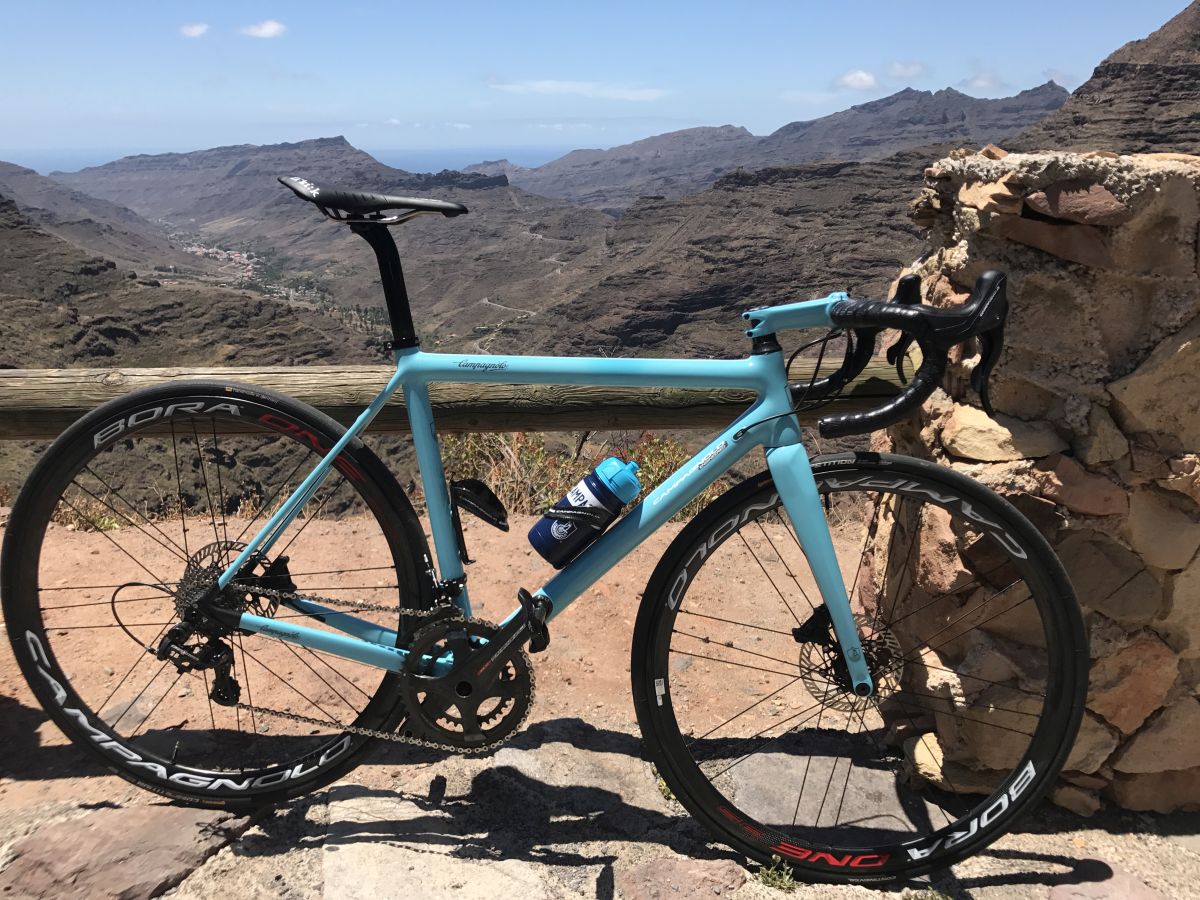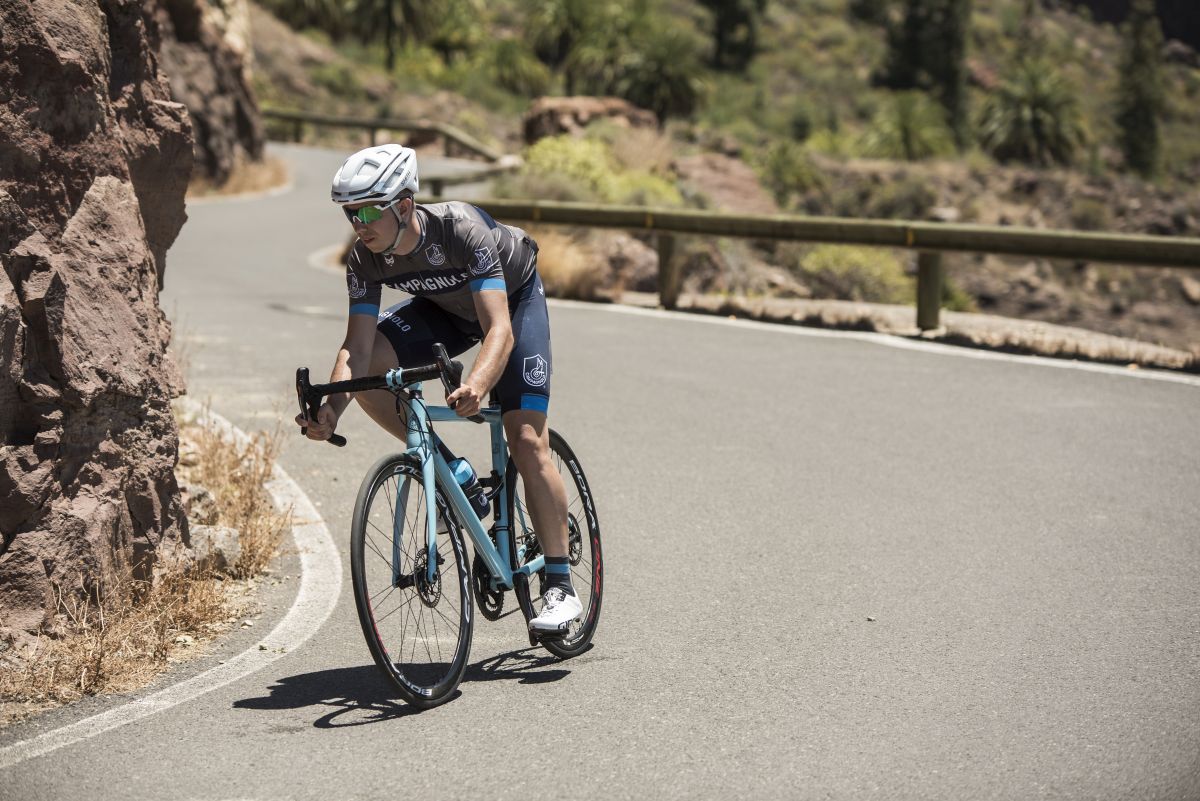First ride on the Campagnolo H11 disc brakes
Taking the Italian company’s new rotors up and down the climbs of Gran Canaria


The mountains of Gran Canaria seem to rise out of the Atlantic Ocean. It’s extraordinary terrain for riding as long as you don’t mind climbing. The location is a great spot for a first ride on the Campagnolo H11 disc brakes. What goes up must come down after all. The descents are long, steep and technical requiring constant control over speed to navigate the sweeping switchbacks. It was atop a Sarto frame outfitted with Campagnolo H11 disc brakes and crankset, paired with Super Record 11 derailleurs and a Bora One DB 35 tubular wheelset that I had my first experience with the Italian company’s new hydraulic disc-brake offering.
RELATED: Debut of the new Campagnolo H11 disc brakes
Campagnolo’s hoods are very comfortable. I was cautiously optimistic about the feel of the new ones after hearing that the company worked to maintain the same ergonomics on the H11 levers despite the new hydraulic hardware within. On the hoods, I was very impressed to discover the feel is identical. The master cylinder is housed in such away that the extra 8 mm of height does not affect Campagnolo’s excellent ergonomics found across their lineup on the Super Record, Record, Chorus, Potenza and Centaur levers. Campagnolo has done a great job with the H11 Ergopower levers and riders should expect to have the same control of their derailleurs regardless whether the choose a mechanical or EPS setup.

The upper parts of the hoods do feel different but Campagnolo has done a nice job of making the shape a good spot to hold on to, especially in an aggressive position with your arms at 90 degrees to get aero at top the bike. It’s a part of the hoods that Shimano and SRAM, even on their rim brake models, seem to have paid little attention to. I was happy to see Campagnolo make use of the extra 8 mm required for the master cylinder. The hoods also had space for a three-finger wrap. I did not find my hand position changed from riding the Centaur groupset the day before. In contrast to the Centaur, the H11 hoods do offer a better hold of the controls in that aggressive position.
The new hoods are quite elegant to look at as well, with the curved lever maintaining the esthetics Campagnolo has achieved with their other offerings. Only Shimano’s Dura-Ace Di2 9100 levers have better replicated the feel and look of its rim brake counterpart. As for the Campy calipers, they are some of the most discrete offerings I have seen. They do an excellent job of leaving the lines of the bike undisturbed. The calipers paired with their stylish round rotors make for a great-looking package.

The first time I engaged the brakes I wasn’t going fast. The system, however, responded almost immediately to the force I had applied. There is very little empty space between the pull of the lever and the engagement of the brake pads, which they do predictably. On the day’s big descent on Gran Canaria, I was reminded why I love riding disc brakes in the mountains. The hairpin turns required heavy braking, taking me from more than 60 km/h to around 15 km/h. I could scrub my speed quickly with the strength of one finger at each lever. I was certainly confident braking later than I had been the day before on rim brakes. Through some of the wider turns where I could hold more speed, I experienced the excellent modulation with the smooth lever action. When I needed to brake suddenly in a couple of unfamiliar turns, the system allowed me to do so in a calm and precise manner. It didn’t take long before I knew just how much force I needed to apply to get the type of braking performance required to navigate each section of the descent safely.
The levers have two positions that affect their behaviour. There’s S (for short) and L (for long). The short position offer quicker braking engagement, while the long position lets you pull the levers a bit before the pads start slowing the rotors. The difference between the settings is subtle. I knew I preferred the short setting, but it wasn’t remarkably different from the long. Riders who want their disc brakes to have a more rim-brake feel should opt for the long pull setting. I, however, think that setting doesn’t not quite hit that mark for simulating rim brakes. Not a problem though. I like the immediacy of engagement on the short setting.
After heavy braking, the pads and lever return to their unengaged positions as I expected they would. The system is pleasantly quiet as well. Testing in wetter conditions was regrettably not possible on sunny Gran Canaria.

On one section of the descent, I stopped at a lookout. I was curious to see how hot the rotors were. Carefully, I tapped a disc. It definitely had some heat to it, but it wasn’t scalding. After taking a quick picture of the bike, I reached down again and was impressed: the heat had almost entirely dissipated.
Having spent a lot of time on Shimano’s RS series disc brakes, I can confidently say the comfort, control and feel of Campagnolo’s disc brakes are a significant improvement. The system feels more refined; the lever return is much quicker. The braking is more controlled from the first pull of each lever. The brake engagement feels precise and, most important, predictable. With the Dura-Ace discs, Shimano has addressed many of the shortfalls of their previous system. For me, it will take more time on both the Shimano and Campy systems to make better comparisons.

The Campagnolo H11 disc brakes are a step forward in the category overall. The groupset has refined ergonomics and performance. The esthetics stay as true as possible to Campagnolo’s other beautiful offerings. Paired with the excellent shift action of Super Record, the H11 offers the performance worthy of any top-end machine.
Read more for all the details of the Campagnolo H11 and Potenza disc brakes.
